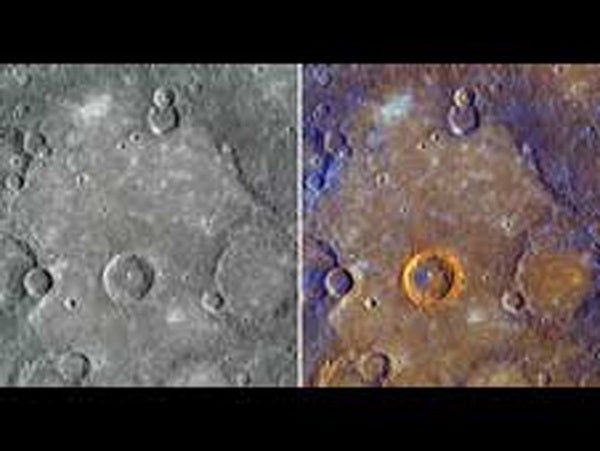A NASA spacecraft gliding over the surface of Mercury has revealed that the planet’s atmosphere, the interaction of its surrounding magnetic field with the solar wind, and its geological past display greater levels of activity than scientists first suspected. The probe also discovered a previously unknown large impact basin about 430 miles (690 kilometers) in diameter – equal to the distance between Washington, D.C., and Boston.
The data come from the MErcury Surface, Space ENvironment, GEochemistry, and Ranging spacecraft, known as MESSENGER. On October 6, 2008, the probe flew by Mercury for the second time, capturing more than 1,200 high-resolution and color images of the planet. The probe unveiled another 30 percent of the planet’s surface that previous spacecraft had never seen and gathered essential data for planning the remainder of the mission.
“This second Mercury flyby provided a number of new findings,” said Sean Solomon, the probe’s principal investigator from the Carnegie Institution of Washington. “One of the biggest surprises was how strongly the dynamics of the planet’s magnetic field-solar wind interaction changed from what we saw during the first Mercury flyby in January 2008. The discovery of a large and unusually well-preserved impact basin shows concentrated volcanic and deformational activity.”
The spacecraft also made the first detection of magnesium in Mercury’s thin atmosphere, known as an exosphere. This observation and other data confirm that magnesium is an important part of Mercury’s surface materials.
The probe’s Mercury Atmospheric and Surface Composition Spectrometer instrument detected the magnesium. Finding magnesium was not surprising to scientists, but seeing it in the amounts and distribution observed was unexpected. The instrument also measured other exospheric constituents, including calcium and sodium.
“This is an example of the kind of individual discoveries that the science team will piece together to give us a new picture of how the planet formed and evolved,” said William McClintock from the Laboratory for Atmospheric and Space Physics at the University of Colorado at Boulder. He suspects that additional metallic elements from the surface, including aluminum, iron, and silicon, also contribute to the exosphere.
The variability that the spacecraft observed in Mercury’s magnetosphere – the volume of space dominated by the planet’s magnetic field – so far supports the hypothesis that the great day-to-day changes in Mercury’s atmosphere may be a result of changes in the shielding provided by the magnetosphere.
“The spacecraft observed a radically different magnetosphere at Mercury during its second flyby compared with its earlier January 14 encounter,” said James Slavin from NASA’s Goddard Space Flight Center in Greenbelt, Maryland. “During the first flyby, important discoveries were made, but scientists didn’t detect any dynamic features. The second flyby witnessed a totally different situation.”
The spacecraft’s discovery of the impact basin, called Rembrandt, is the first time scientists have seen terrain well-exposed on the floor of a large impact basin on Mercury. Volcanic flows usually completely bury landforms such as those revealed on the floor of Rembrandt.
“This basin formed about 3.9 billion years ago, near the end of the period of heavy bombardment of the inner solar system,” said Thomas Watters from the Smithsonian Institution in Washington. “Although ancient, the Rembrandt basin is younger than most other known impact basins on Mercury.”
Half of Mercury was unknown until a little more than a year ago. Globes of the planet were blank on one side. Spacecraft images have enabled scientists to see 90 percent of the planet’s surface at high resolution. The spacecraft’s nearly global imaging coverage of the surface after the second flyby gives scientists fresh insight into how the planet’s crust formed.
“After mapping the surface, we see that approximately 40 percent is covered by smooth plains,” said Brett Denevi of Arizona State University in Tempe. “Many of these smooth plains are interpreted to be of volcanic origin, and they are globally distributed. Much of Mercury’s crust may have formed through repeated volcanic eruptions in a manner more similar to the crust of Mars than to that of the Moon.”
Scientists continue to examine data from the first two flybys and are preparing to gather more information from a third flyby of the planet September 29.
“The third Mercury flyby is our final dress rehearsal for the main performance of our mission, the insertion of the probe into orbit around Mercury in March 2011,” said Solomon. “The orbital phase will be like staging two flybys per day and will provide the continuous collection of information about the planet and its environment for one year. Mercury has been coy in revealing its secrets slowly so far, but in less than 2 years the innermost planet will become a close friend.”










